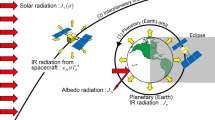Abstract
Planetary missions of the future will have increasingly greater energy requirements due to the desire for in-situ investigations and faster flight times. Solar electric propulsion provides a means of more effectively accomplishing these types of missions. The first planetary low-thrust mission will be launched in July 1998, and fly by an asteroid, a comet, and the planet Mars. This mission will demonstrate solar electric propulsion technology, and lay the groundwork for more exciting missions in the future. Three missions representative of the types of future missions for which solar electric propulsion might be used are shown. In each case, the performance of solar electric propulsion and chemical options are compared.
Similar content being viewed by others
References
RAYMAN, M. D., and LEHMAN, D. H. “NASA’s First New Millennium Deep-Space Technology Validation Flight,” Paper No. IAA-L-0502, Second IAA International Conference on Low-Cost Planetary Missions, Laurel, Maryland, April 1996.
SAUER, C. G. JR. “Optimization of Multiple Target Electric Propulsion Trajectories,” Paper No. 73–205, AIAA 11th Aerospace Sciences Meeting, Washington, D. C., January 1973.
WILLIAMS, S. N. “An Introduction to the Use of VARITOP: A General Purpose Low Thrust Trajectory Optimization Program,” JPL Internal Document D-11475, Jet Propulsion Laboratory, Pasadena, California, January 1994.
COVERSTONE-CARROLL, V., and WILLIAMS, S. N. “Optimum Low Thrust Trajectories Using Differential Inclusion Concepts,” Journal of the Astronautical Sciences, Vol. 42, No. 4, October–December 1994.
RAWLIN, V. K. “Power Throttling the NSTAR Thruster,” Paper No. 95–2515, 31st AIAA/SAE/ASME/ASEE Joint Propulsion Conference and Exhibit, San Diego, California, July 1995.
VEVERKA, J., LANGEVIN, Y., FARQUHAR, R., and FULCHIGNONI, M. “Spacecraft Exploration of Asteroids: The 1988 Perspective,” Asteroids II, The University of Arizona Press, Tucson 1989.
SAUER, C. G. JR., and YEN, C. L. “Multiple Main-Belt Asteroid Mission Options for a Mariner Mark II Spacecraft,” Paper No. 89–434, AAS/AIAA Astrodynamics Specialist Conference, Stowe, Vermont, August 1993.
SIMS, J. A., STAUGLER, A. J., and LONGUSKI, J. M. “Trajectory Options to Pluto via Gravity Assists from Venus, Mars, and Jupiter,” Paper No. 96–3614, AAS/AIAA Astrodynamics Specialist Conference, San Diego, California, 1996.
SAUER, C. G. JR. Personal Communication, August 1995.
MELBOURNE, W. G., and SAUER, C. G. JR. “Performance Computations With Pieced Solutions of Planetocentric and Heliocentric Trajectories for Low-Thrust Missions,” JPL Space Programs Summary No. 37–36, Vol. IV, Jet Propulsion Laboratory, Pasadena, California, 1965.
Author information
Authors and Affiliations
Rights and permissions
About this article
Cite this article
Williams, S.N., Coverstone-Carroll, V. Benefits of Solar Electric Propulsion for the Next Generation of Planetary Exploration Missions. J of Astronaut Sci 45, 143–159 (1997). https://doi.org/10.1007/BF03546373
Published:
Issue Date:
DOI: https://doi.org/10.1007/BF03546373




